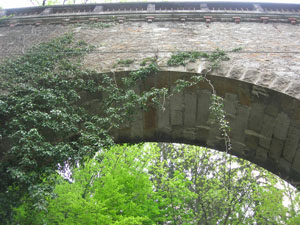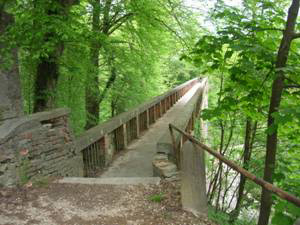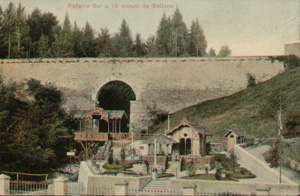| Card n. | Description | Locality | Linked sites |
| 54 | Fisterre Bridge | Belluno | 56 - 8 - 145 |
| file .pdf | Architecture Art History (ASA) | Google maps |
 |
 |
 |
- Description
- How to get there
- Interesting facts
- Bibliography
Not far upstream from Belluno is Fisterre, a place well known to the locals because on the edge of the area is the public park of Mussoi, once part of the gardens of a noble villa. Right next to the park is the Ponte delle Fontane, a single-span stone bridge that is today used as a pedestrian walkway, but whose origins go back a long way. Although it is believed the bridge may date back as far as Roman times, the earliest documents attesting to the existence here of a pons fontium, are from the late Middle Ages. Over the centuries, frequent maintenance work was carried out on the suspended aqueduct, because until the Libano, or “Roncole” aqueduct was built in 1899, it was the only one serving the town of Belluno. In 1555 the Rector Lorenzo Bragadin decided it should be extended, and in 1750 it was rebuilt and strengthened thanks to the Magistrate and Prefect Matteo Badoer, as can be read on the stone built into the entrance of the bridge, which was repaired in 1921 after the First World War.
From the Alpini Bridge at the entrance to the town of Belluno, take the SR204 Agordina road; after 800 m on the right you will find signs for the village of Bolzano Bellunese; once you take Via Travazzoi and go along for a hundred metres or so, on the right you will see Mussoi Park, which stretches along the banks of an affluent of the Ardo. The bridge can also be reached from Via Michele Cappellari, which branches off to the right just after the fuel station. Leave your car in the parking area, and take the good dirt road that leads up onto the bridge at the eastern entrance to the park, from which it is possible to spot the fish farm below, along the banks of the Ardo.
ACCESSIBLE: on foot from Via Travazzoi through Mussoi Park, or from the road opposite the “Salsa-D'Angelo” barracks of the Alpina Cadore Regiment in Mussoi, in Via Col di Lana
MUNICIPALITY: Belluno
PLACE: Fisterre
GEOGRAPHICAL COORDINATES: X 1747715 – Y 5115614
PROVINCE: Belluno
FILE COMPILED BY: Guadagnin
In the immediate surroundings, visible from the “Ponte delle donne” bridge, is the Fisterre Fish Farm (8 IA) or Royal Trout Farm, active until 1975 and now in a state of abandon. The fish farm, which began life as a mill and fulling plant, dates back to the beginning of the 19th century, and was powered by the water from a channel that started out from the present-day dyke of Fisterre and along the way supplied water to various mils, workshops and fountains. It was Feliciano Vivanti, manager of the Fish Farm and Mayor of Belluno from 1902 to 1905, who decided to set up an entertainment facility here, featuring a “wooden chalet and veranda designed to create…an attractive alpine meeting place…” in thearea between the bridge and the farm.
The pedestrian path that runs alongside the Ardo torrent leads to the Fisterre Hydroelectric Plant (145 IA/CA), now no longer in use, which until 1908 supplied energy for the public and private lighting system of the town, as well as power to the factories in Cavarzano and Sois. The complex, composed of two buildings, is interesting for its masonry structure in local stone and for the use of brickwork, also for ornamental purposes. The area between Borgo Prà and Fisterre, which offers a wealth of historical, cultural and natural points of interest, can be explored along a series of paths and lanes that lead to the mouth of the first ravine upstream from the power station.
O. Ceiner, Il Ponte delle Fontane di Fisterre: appunti note per la storia dell’acquedotto di Belluno, September 2003
A. Costa, Giardini della Provincia di Belluno, Belluno, 2002
M. Dal Mas, R. Dal Mas, Le Fontane di Belluno, Belluno, 1993
G. De Bortoli, A. Moro, F. Vizzutti, Belluno storia architettura arte, Belluno, 1984
F. Miari, Dizionario storico – artistico – letterario bellunese, Bologna, 1968

